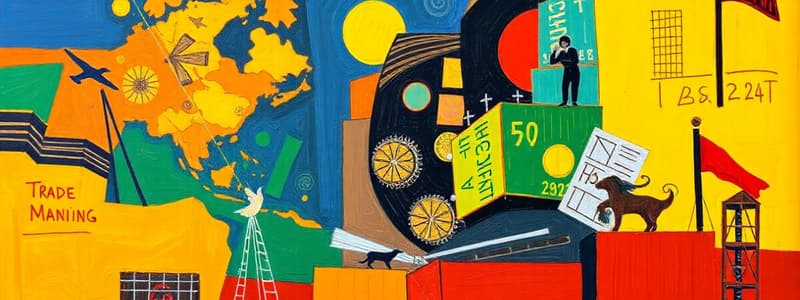Podcast
Questions and Answers
What disease was imported from Europe in 1567 that killed two million people?
What disease was imported from Europe in 1567 that killed two million people?
Typhoid fever
Which staple food was brought from South America to Europe in 1600?
Which staple food was brought from South America to Europe in 1600?
- Potatoes (correct)
- Corn
- Tomatoes
- Quinoa
In which year did Japan begin trading silver for foreign goods?
In which year did Japan begin trading silver for foreign goods?
1600
What was the first Navigation Act passed by England aimed at?
What was the first Navigation Act passed by England aimed at?
The Chinese allowed unrestricted foreign trade in 1760.
The Chinese allowed unrestricted foreign trade in 1760.
Who was the U.S. President that banned trade with Europe in 1807?
Who was the U.S. President that banned trade with Europe in 1807?
What economic theory did David Ricardo publish in 1817?
What economic theory did David Ricardo publish in 1817?
Britain was the last country to adopt the gold standard.
Britain was the last country to adopt the gold standard.
The __________ Treaty, signed in 1860, aimed to create free trade between Britain and France.
The __________ Treaty, signed in 1860, aimed to create free trade between Britain and France.
What significant agreement was negotiated in 1944?
What significant agreement was negotiated in 1944?
Flashcards
Comparative Advantage
Comparative Advantage
The ability of a country to produce a good or service at a lower opportunity cost than another country.
Absolute Advantage
Absolute Advantage
The ability of a country to produce a good or service using fewer resources than another country.
Navigation Acts
Navigation Acts
British laws requiring colonial trade to be conducted only with British ships.
International Trade
International Trade
Signup and view all the flashcards
Trade Barriers
Trade Barriers
Signup and view all the flashcards
Gold Standard
Gold Standard
Signup and view all the flashcards
Bretton Woods Agreement
Bretton Woods Agreement
Signup and view all the flashcards
Factor Proportions
Factor Proportions
Signup and view all the flashcards
Balance of Payments
Balance of Payments
Signup and view all the flashcards
Trade Agreement
Trade Agreement
Signup and view all the flashcards
Study Notes
International Trade Agreements
- International trade is the exchange of goods and services between countries
- International trade theories explain why countries trade and how trade affects countries' economies.
Evolution of Trade
- 1004: Chinese unity fractured.
- 1025: Chola navy defeated Srivijaya.
- 1100: Japan isolated itself.
- 1200: Islam introduced to Southeast Asia via spice traders.
- 1269: England institutes toll roads.
- 1270: Venetian Marco Polo travels through Asia.
- 1392: England prohibited foreign retail.
- 1404: China restricted private trading.
- 1425: Bruges became a major seaport.
- 1430: Portuguese prince explored the west African coast.
- 1470: Persian imitation of Chinese porcelain.
- 1500: Rise of slave trade.
- 1531: Antwerp stock exchange.
- 1555: Introduction of tobacco to Europe
- 1561: Tulips introduced to Europe.
- 1567: Typhoid fever in South America (2 million deaths)
- 1600: Introduction of potatoes to Europe.
- 1609: Dutch begin fur trade in Manhattan
- 1611: Japan limited Dutch trade.
- 1651: English Navigation Acts restricted Dutch trade.
- 1760: Restrictions on foreign trade in China.
- 1807: US President Jefferson banned trade with Europe.
- 1817: David Ricardo's theory of comparative advantage.
- 1821: Britain adopts the gold standard.
- 1844: China opened 5 ports to US ships.
- 1851: First world's fair in London.
- 1857: US adopted the gold standard.
- 1860: Cobden Treaty aimed to create free trade.
- 1890: McKinley Tariff Act in the US.
- 1917: US abandons the gold standard.
- 1938: Development of xerography
- 1944: Bretton Woods Agreement.
- 1947: Establishment of GATT.
- 1957: European Economic Community (EEC) established.
- 1971: US abandons the gold standard.
- 1973: Arab oil embargo.
- 1994: NAFTA established.
- 1995: World Trade Organization (WTO) established.
- 1997: Hong Kong returned under Chinese rule.
- 2000: WTO had 130 members (over 90% of world trade)
Trade Theories
- Mercantilism: Wealth measured by gold and silver; Encourage exports, discourage imports.
- Absolute Advantage: One country is more efficient at producing a good than another. Specialization and trade benefit both.
- Comparative Advantage: Specialization and trade are beneficial even if one country is more efficient in all goods.
- Heckscher-Ohlin (Factor Proportions) Theory: Countries export goods that use their abundant factors.
- Product Life Cycle Theory: Products' production and consumption patterns shift over their life cycle.
- Country Similarity Theory: Countries with similar characteristics tend to trade more.
- Porter's National Competitive Advantage Theory: Four factors (factor conditions, demand conditions, related and supporting industries, and firm strategy, structure, and rivalry) influence a nation's competitiveness.
Studying That Suits You
Use AI to generate personalized quizzes and flashcards to suit your learning preferences.




